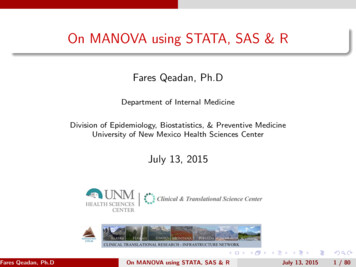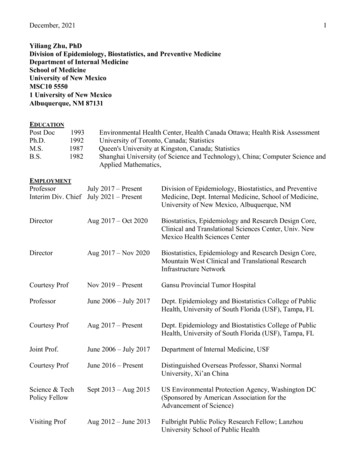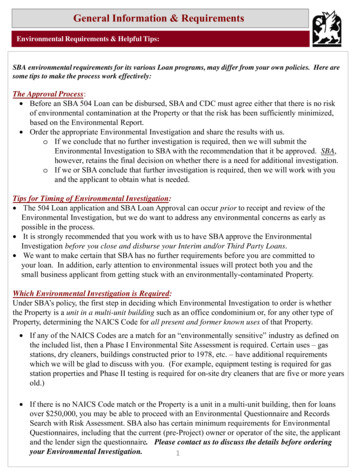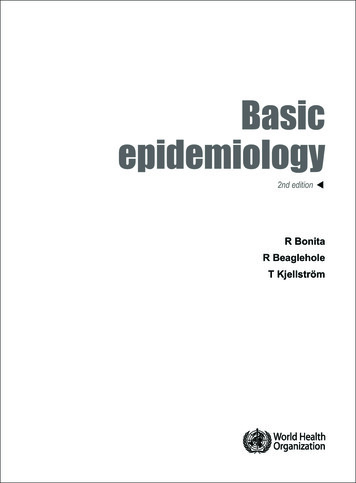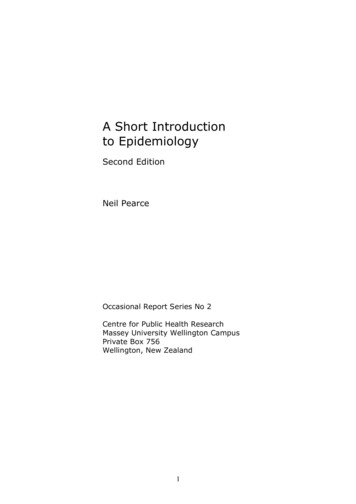
Transcription
http://www.nap.edu/catalog/1802.htmlWe ship printed books within 1 business day; personal PDFs are available immediately.Environmental Epidemiology, Volume 1: PublicHealth and Hazardous WastesCommittee on Environmental Epidemiology, Board onEnvironmental Studies and Toxicology, NationalResearch CouncilISBN: 0-309-53758-4, 296 pages, 6 x 9, (1991)This PDF is available from the National Academies Press at:http://www.nap.edu/catalog/1802.htmlVisit the National Academies Press online, the authoritative source for all booksfrom the National Academy of Sciences, the National Academy of Engineering,the Institute of Medicine, and the National Research Council: Download hundreds of free books in PDF Read thousands of books online for free Explore our innovative research tools – try the “Research Dashboard” now! Sign up to be notified when new books are published Purchase printed books and selected PDF filesThank you for downloading this PDF. If you have comments, questions orjust want more information about the books published by the NationalAcademies Press, you may contact our customer service department tollfree at 888-624-8373, visit us online, or send an email tofeedback@nap.edu.This book plus thousands more are available at http://www.nap.edu.Copyright National Academy of Sciences. All rights reserved.Unless otherwise indicated, all materials in this PDF File are copyrighted by the NationalAcademy of Sciences. Distribution, posting, or copying is strictly prohibited withoutwritten permission of the National Academies Press. Request reprint permission for this book.
About this PDF file: This new digital representation of the original work has been recomposed from XML files created from the original paper book, not from theoriginal typesetting files. Page breaks are true to the original; line lengths, word breaks, heading styles, and other typesetting-specific formatting, however, cannot beretained, and some typographic errors may have been accidentally inserted. Please use the print version of this publication as the authoritative version for attribution.Environmental Epidemiology, Volume 1: Public Health and Hazardous mentalEpidemiologyVolume 1Public Health and Hazardous WastesCommittee on Environmental EpidemiologyBoard on Environmental Studies and ToxicologyCommission on Life SciencesNATIONAL RESEARCH COUNCILNATIONAL ACADEMY PRESSWashington, D.C. 1991Copyright National Academy of Sciences. All rights reserved.
About this PDF file: This new digital representation of the original work has been recomposed from XML files created from the original paper book, not from theoriginal typesetting files. Page breaks are true to the original; line lengths, word breaks, heading styles, and other typesetting-specific formatting, however, cannot beretained, and some typographic errors may have been accidentally inserted. Please use the print version of this publication as the authoritative version for attribution.Environmental Epidemiology, Volume 1: Public Health and Hazardous AL ACADEMY PRESS 2101 Constitution Ave. Washington, D.C. 20418NOTICE: The project that is the subject of this report was approved by the Governing Board of theNational Research Council, whose members are drawn from the councils of the National Academyof Sciences, the National Academy of Engineering, and the Institute of Medicine. The members ofthe committee responsible for the report were chosen for their special competencies and with regardfor appropriate balance.This report has been reviewed by a group other than the authors according to procedures approvedby a Report Review Committee consisting of members of the National Academy of Sciences, theNational Academy of Engineering, and the Institute of Medicine.National Research Council (U.S.). Committee on Environmental Epidemiology.Environmental epidemiology / Committee on Environmental Epidemiology, Board on Environmental Studies and Toxicology.Commission on Life Sciences, National Research Council.p. cm.Includes bibliographical references and index.Contents: v. 1. Public health and hazardous waste.ISBN 0-309-04496-0 (v. 1)1. Environmental health. 2. Epidemiology. I. Title.[DNLM: 1. Epidemiologic Methods. 2. Hazardous Waste—adverse effects. 3. Refuse Disposal. WA788 N275e]RA565.N323 1991363.72'87—dc20DNLM/DLCfor Library of Congress 91-28051CIPCover photograph: LES MOORE/UNIPHOTOCopyright 1991 by the National Academy of SciencesNo part of this book may be reproduced by any mechanical, photographic, or electronic process, or in the form of a phonographic recording, nor may it be stored in a retrieval system, transmitted, or otherwise copied for public or private use, without written permission from the publisher,except for the purposes of official use by the U.S. government.Printed in the United States of AmericaFirst Printing, August 1991Second Printing, March 1993Copyright National Academy of Sciences. All rights reserved.
About this PDF file: This new digital representation of the original work has been recomposed from XML files created from the original paper book, not from theoriginal typesetting files. Page breaks are true to the original; line lengths, word breaks, heading styles, and other typesetting-specific formatting, however, cannot beretained, and some typographic errors may have been accidentally inserted. Please use the print version of this publication as the authoritative version for attribution.Environmental Epidemiology, Volume 1: Public Health and Hazardous TTEE ON ENVIRONMENTAL EPIDEMIOLOGYANTHONY B. MILLER (Chairman),University of Toronto, Ontario, CanadaDAVID BATES, University of British Columbia, CanadaTHOMAS CHALMERS, Department of Veterans' Affairs and Harvard Schoolof Public Health, Boston, MassachusettsMOLLY JOEL COYE, California Department of Health ServicesJOHN FROINES, UCLA School of Public Health, Los AngelesDAVID HOEL, National Institute of Environmental Health Services, ResearchTriangle Park, North CarolinaJOEL SCHWARTZ, United States Environmental Protection Agency,Washington, D.C.Special AdvisorPAUL SCHULTE, National Institute for Occupational Safety and Health,Cincinnati, OhioStaffDEVRA LEE DAVIS, Scholar in ResidenceLINDA MILLER POORE, Research AssociatePAULETTE ADAMS, Project AssistantCopyright National Academy of Sciences. All rights reserved.
About this PDF file: This new digital representation of the original work has been recomposed from XML files created from the original paper book, not from theoriginal typesetting files. Page breaks are true to the original; line lengths, word breaks, heading styles, and other typesetting-specific formatting, however, cannot beretained, and some typographic errors may have been accidentally inserted. Please use the print version of this publication as the authoritative version for attribution.Environmental Epidemiology, Volume 1: Public Health and Hazardous Wasteshttp://www.nap.edu/catalog/1802.htmlivBOARD ON ENVIRONMENTAL STUDIES ANDTOXICOLOGYGILBERT S. OMENN (Chairman), University of Washington, SeattleFREDERICK R. ANDERSON, Washington School of Law, AmericanUniversity, Washington, D.C.JOHN C. BAILAR III, McGill University School of Medicine, Montreal,CanadaLAWRENCE W. BARNTHOUSE, Oak Ridge National laboratory, OakRidge, TennesseeGARY D. BREWER, Yale University, New Haven, ConnecticutJOANNA BURGER, Nelson Laboratory, Rutgers University, Piscataway,New JerseyYORAM COHEN, University of California, Los AngelesJOHN L. EMMERSON, Lilly Research Laboratories, Greenfield, IndianaROBERT L. HARNESS, Monsanto Agricultural Company, St. Louis, MissouriALFRED G. KNUDSON, Fox Chase Cancer Center, Philadelphia, PennsylvaniaGENE E. LIKENS, The New York Botanical Garden, Millbrook, New YorkPAUL J. LIOY, UMDNJ-Robert Wood Johnson Medical School, Piscataway,New JerseyJANE LUBCHENCO, Oregon State University, CorvallisDONALD MATTISON, University of Pittsburgh, PennsylvaniaNATHAN REED, Hobe Sound, FloridaF. SHERWOOD ROWLAND, University of California, IrvineMILTON RUSSELL, University of Tennessee, KnoxvilleMARGARET M. SEMINARIO, AFL/CIO, Washington, D.C.I. GLENN SIPES, University of Arizona, TucsonWALTER J. WEBER, JR., University of Michigan, Ann ArborStaffJAMES J. REISA, DirectorDAVID POLICANSKY, Program Director for Natural Resources and AppliedEcologyROBERT B. SMYTHE, Program Director for Exposure Assessment and RiskReductionRICHARD D. THOMAS, Program Director for Human Toxicology and RiskAssessmentLEE R. PAULSON, Manager, Toxicology Information CenterCopyright National Academy of Sciences. All rights reserved.
About this PDF file: This new digital representation of the original work has been recomposed from XML files created from the original paper book, not from theoriginal typesetting files. Page breaks are true to the original; line lengths, word breaks, heading styles, and other typesetting-specific formatting, however, cannot beretained, and some typographic errors may have been accidentally inserted. Please use the print version of this publication as the authoritative version for attribution.Environmental Epidemiology, Volume 1: Public Health and Hazardous ION ON LIFE SCIENCESBRUCE M. ALBERTS (Chairman), University of California, San FranciscoBRUCE N. AMES, University of California, BerkeleyFRANCISCO J. AYALA, University of California, IrvineJ. MICHAEL BISHOP, University of California, San FranciscoMICHAEL T. CLEGG, University of California, RiversideGLENN A. CROSBY, Washington State University, PullmanFREEMAN J. DYSON, The Institute of Advanced Study, Princeton, New JerseyLEROY E. HOOD, California Institute of Technology, PasadenaDONALD F. HORNIG, Harvard School of Public Health, Boston,MassachusettsMARIAN E. KOSHLAND, University of California, BerkeleyRICHARD E. LENSKI, University of California, IrvineSTEVEN P. PAKES, University of Texas, DallasEMIL A. PFITZER, Hoffmann-LaRoche, Inc., Nutley, New JerseyTHOMAS D. POLLARD, The Johns Hopkins Medical School, Baltimore,MarylandJOSEPH E. RALL, National Institutes of Health, Bethesda, MarylandRICHARD D. REMINGTON, University of Iowa, Iowa CityPAUL G. RISSER, University of New Mexico, AlbuquerqueHAROLD M. SCHMECK, JR., Armonk, New YorkRICHARD B. SETLOW, Brookhaven National Laboratory, Upton, New YorkCARLA J. SHATZ, Stanford University School of Medicine, Palo Alto,CaliforniaTORSTEN N. WIESEL, Rockefeller University, New York, New YorkStaffJOHN E. BURRIS, Executive DirectorSOLVEIG M. PADILLA, Administrative SecretaryCopyright National Academy of Sciences. All rights reserved.
About this PDF file: This new digital representation of the original work has been recomposed from XML files created from the original paper book, not from theoriginal typesetting files. Page breaks are true to the original; line lengths, word breaks, heading styles, and other typesetting-specific formatting, however, cannot beretained, and some typographic errors may have been accidentally inserted. Please use the print version of this publication as the authoritative version for attribution.Environmental Epidemiology, Volume 1: Public Health and Hazardous Wasteshttp://www.nap.edu/catalog/1802.htmlviThe National Academy of Sciences is a private, non-profit, selfperpetuating society of distinguished scholars engaged in scientific andengineering research, dedicated to the furtherance of science and technologyand to their use for the general welfare. Upon the authority of the chartergranted to it by the Congress in 1863, the Academy has a mandate that requiresit to advise the federal government on scientific and technical matters. Dr.Frank Press is president of the National Academy of Sciences.The National Academy of Engineering was established in 1964, underthe charter of the National Academy of Sciences, as a parallel organization ofoutstanding engineers. It is autonomous in its administration and in the selectionof its members, sharing with the National Academy of Sciences theresponsibility for advising the federal government. The National Academy ofEngineering also sponsors engineering programs aimed at meeting nationalneeds, encourages education and research, and recognizes the superiorachievements of engineers. Dr. Robert M. White is president of the NationalAcademy of Engineering.The Institute of Medicine was established in 1970 by the NationalAcademy of Sciences to secure the services of eminent members of appropriateprofessions in the examination of policy matters pertaining to the health of thepublic. The Institute acts under the responsibility given to the NationalAcademy of Sciences by its congressional charter to be an adviser to the federalgovernment and, upon its own initiative, to identify issues of medical care,research, and education. Dr. Samuel O. Their is president of the Institute ofMedicine.The National Research Council was organized by the National Academyof Sciences in 1916 to associate the broad community of science andtechnology with the Academy's purposes of furthering knowledge and advisingthe federal government. Functioning in accordance with general policiesdetermined by the Academy, the Council has become the principal operatingagency of both the National Academy of Sciences and the National Academy ofEngineering in providing services to the government, the public, and thescientific and engineering communities. The Council is administered jointly byboth Academies and the Institute of Medicine. Dr. Frank Press and Dr. RobertM. White are chairman and vice chairman, respectively, of the NationalResearch Council.The project was supported by the Agency for Toxic Substances andDisease Registry, U.S. Public Health Service, Department of Health and HumanServices.www.national-academies.orgCopyright National Academy of Sciences. All rights reserved.
About this PDF file: This new digital representation of the original work has been recomposed from XML files created from the original paper book, not from theoriginal typesetting files. Page breaks are true to the original; line lengths, word breaks, heading styles, and other typesetting-specific formatting, however, cannot beretained, and some typographic errors may have been accidentally inserted. Please use the print version of this publication as the authoritative version for attribution.Environmental Epidemiology, Volume 1: Public Health and Hazardous iiPrefaceIn response to a request from the Agency for Toxic Substances andDisease Registry (ATSDR), the Board on Environmental Studies andToxicology in the Commission on Life Sciences of the National ResearchCouncil (NRC) convened the Committee on Environmental Epidemiology. TheBoard charged the Committee to review current knowledge of the human healtheffects caused by exposure to hazardous-waste sites and to suggest how toimprove the scientific bases for evaluating the effects of environmentalpollution on public health, including specifically the conduct of healthassessments at Superfund sites. This first report of the committee examines andevaluates the published scientific literature on health effects that could be linkedwith exposure to hazardous-waste disposal sites, and developsrecommendations about major data gaps that need to be remedied in order toadvance the field.With additional support from the Environmental Protection Agency, asecond report of the committee will identify research opportunities and issues inmethodology for environmental epidemiology and will select and evaluate asample of non-peer-reviewed reports on the subject of the epidemiologic studyof hazardous-wastes. This literature includes such sources as state healthdepartment reports and relevant technical evaluations from judicial decisionsthat have been subject to extensive review, but are not available in the peerreviewedCopyright National Academy of Sciences. All rights reserved.
About this PDF file: This new digital representation of the original work has been recomposed from XML files created from the original paper book, not from theoriginal typesetting files. Page breaks are true to the original; line lengths, word breaks, heading styles, and other typesetting-specific formatting, however, cannot beretained, and some typographic errors may have been accidentally inserted. Please use the print version of this publication as the authoritative version for attribution.Environmental Epidemiology, Volume 1: Public Health and Hazardous iiiliterature. To the extent feasible, the second report also will assess newlyavailable reports from Eastern Europe and Asia that may be relevant.In light of the paucity of information readily available, the Committeestruggled with its charge early on. We developed the policy of looking at peerreviewed, published studies of persons exposed at hazardous-waste sites, andalso examining those studies involving environmental exposures similar tothose that might be found at such sites.The chapters reflect the consensus of the committee. We are grateful to anumber of colleagues who provided drafts and critiques of sections of the reportfor the Committee, including Drs. Diane Wagener, Director of EnvironmentalEpidemiology at the National Center for Health Statistics; Claire Weinberg,National Institute of Environmental Health Sciences; Peter Infante, HealthStandards Division, the Occupational Safety and Health Administration; KenCantor, Environmental Epidemiology Branch, National Cancer Institute; LynnGoldman, Public Health Administrator, State of California; and MarvinSchneiderman, Senior Scientist, NRC. In preparing this report, we have metwith citizen groups, industry representatives and state officials (including theNational Governors' Association Task Force on Environmental Epidemiology),all of whom provided valuable suggestions. Dr. Barry Johnson, AssistantAdministrator for the Agency for Toxic Substances (ATSDR), provided helpfulrecommendations and guidance at the outset of the study, as did a number ofmembers of that agency. Dr. Dorothy Canter of EPA assisted us in gatheringrelevant agency information and navigating through the bureaucratic maze.Linda Miller Poore provided able research and administrative support anddocument supervision, and Paulette Adams managed document preparation andmeeting organization. Most importantly, the committee acknowledges itsenormous debt to Dr. Devra Davis, Scholar in Residence, National ResearchCouncil, who not only ably fulfilled the role of project director, but contributedsubstantially to the drafting and revision of all chapters in the report. Withouther skills and input, the report would have lacked much, and our task couldnever have been completed in the timely manner it has been.Finally, as chairman, I should like to thank all of the members of thecommittee for their expertise, input and support throughout our deliberations.ANTHONY B. MILLER, ChairmanCommittee on Environmental EpidemiologyCopyright National Academy of Sciences. All rights reserved.
About this PDF file: This new digital representation of the original work has been recomposed from XML files created from the original paper book, not from theoriginal typesetting files. Page breaks are true to the original; line lengths, word breaks, heading styles, and other typesetting-specific formatting, however, cannot beretained, and some typographic errors may have been accidentally inserted. Please use the print version of this publication as the authoritative version for attribution.Environmental Epidemiology, Volume 1: Public Health and Hazardous ixContentsSummarySECTION ONE Public Health and Hazardous Wastes: The ContextIntroductionState and Federal Context for Environmental Epidemiology ofHazardous WastesDimensions of the Problem: Exposure AssessmentSECTION TWO Hazardous Wastes in Air, Water, Soil, andFood; Biologic MarkersAir ExposuresDomestic Water ConsumptionSoil and Food as Potential Sources of Exposure at HazardousWaste SitesBiologic Markers in Studies of Hazardous-Waste SitesGeneral ConclusionsIndexCopyright National Academy of Sciences. All rights reserved.12560101157179203219256271
About this PDF file: This new digital representation of the original work has been recomposed from XML files created from the original paper book, not from theoriginal typesetting files. Page breaks are true to the original; line lengths, word breaks, heading styles, and other typesetting-specific formatting, however, cannot beretained, and some typographic errors may have been accidentally inserted. Please use the print version of this publication as the authoritative version for attribution.Environmental Epidemiology, Volume 1: Public Health and Hazardous 7-3Summary of studies of residential exposure to hazardous-waste sitesATSDR public health advisoriesCost estimates: Preremedial assessments of hazardous-waste sitesEnvironmental epidemiology: Investigators and funding sourcesRevised preliminary assessment: Estimated costsTypes of activities at hazardous-waste sites in the United StatesSelected hazardous substances at 951 national priorities list sites:Number and percentage of sites and documented migration ofsubstances into specific mediaActivities contributing to groundwater contamination in theUnited StatesHierarchy of exposure data or surrogatesSpatial considerations: Summary of sampling designs and whenthey are most usefulSome common problems with all types of human exposure dataFrequency of substances reported at final and proposed NPL sitesPriority list of substances for toxicological profilesNeuropsychological test batterySteps in the development of a biomarkerBackground levels of some human hemoglobin Figures1-12-12-22-32-43-13-23-33-4Sources of evidence for inferring whether exposures to hazardous-waste sites cause an impact on public healthWhat are the potential threats to the environment that led tolisting on the NPL?Wastes at NPL sites come from many sourcesNPL sites are located in all settings and areasCERCLIS inventory and NPL sitesFew Superfund sites completely cleaned upNPL: Types of activities at 1189 final sitesNPL sites and population resident within 1 and 4 milesPhysical and biological routes of transport of hazardous substances, their release from disposal sites, and potential forhuman exposureCopyright National Academy of Sciences. All rights reserved.3167686981104106114118
About this PDF file: This new digital representation of the original work has been recomposed from XML files created from the original paper book, not from theoriginal typesetting files. Page breaks are true to the original; line lengths, word breaks, heading styles, and other typesetting-specific formatting, however, cannot beretained, and some typographic errors may have been accidentally inserted. Please use the print version of this publication as the authoritative version for attribution.Environmental Epidemiology, Volume 1: Public Health and Hazardous 53-64-17-1xiContinuum from emission of a contaminant to a health effectParameters required to calculate potential and internal doseMean daily deaths in London versus mean smoke (µg/m3),1958-1972Relationship between biomarkers of susceptibility, exposure,and effectCopyright National Academy of Sciences. All rights reserved.122125159221
About this PDF file: This new digital representation of the original work has been recomposed from XML files created from the original paper book, not from theoriginal typesetting files. Page breaks are true to the original; line lengths, word breaks, heading styles, and other typesetting-specific formatting, however, cannot beretained, and some typographic errors may have been accidentally inserted. Please use the print version of this publication as the authoritative version for attribution.Environmental Epidemiology, Volume 1: Public Health and Hazardous iCopyright National Academy of Sciences. All rights reserved.
About this PDF file: This new digital representation of the original work has been recomposed from XML files created from the original paper book, not from theoriginal typesetting files. Page breaks are true to the original; line lengths, word breaks, heading styles, and other typesetting-specific formatting, however, cannot beretained, and some typographic errors may have been accidentally inserted. Please use the print version of this publication as the authoritative version for attribution.Environmental Epidemiology, Volume 1: Public Health and Hazardous ronmental EpidemiologyCopyright National Academy of Sciences. All rights reserved.
About this PDF file: This new digital representation of the original work has been recomposed from XML files created from the original paper book, not from theoriginal typesetting files. Page breaks are true to the original; line lengths, word breaks, heading styles, and other typesetting-specific formatting, however, cannot beretained, and some typographic errors may have been accidentally inserted. Please use the print version of this publication as the authoritative version for attribution.Environmental Epidemiology, Volume 1: Public Health and Hazardous ight National Academy of Sciences. All rights reserved.
About this PDF file: This new digital representation of the original work has been recomposed from XML files created from the original paper book, not from theoriginal typesetting files. Page breaks are true to the original; line lengths, word breaks, heading styles, and other typesetting-specific formatting, however, cannot beretained, and some typographic errors may have been accidentally inserted. Please use the print version of this publication as the authoritative version for attribution.Environmental Epidemiology, Volume 1: Public Health and Hazardous SummaryPART OF OUR MODERN HERITAGE is the increasing volume of waste created byall industrial societies. Today, there also is unprecedented concern over thepotential consequences for public health and the environment of exposure towastes that are deemed hazardous under a variety of regulatory regimes.According to recent opinion polls, the American public believes that Hazardouswastes constitute a serious threat to public health. In contrast, many scientistsand administrators in the field do not share this belief. On the basis of its bestefforts to evaluate the published literature relevant to this subject, the committeecannot confirm or refute either view. A decade after implementation ofSuperfund, and despite congressional efforts to redirect the program, substantialpublic health concerns remain, and critical information on the distribution ofexposures and health effects associated with hazardous-waste sites is stilllacking.Without doubt, however, substances toxic to humans and several animalspecies abound in hazardous-waste sites. Human health studies have shown thatserious health effects cannot be ruled out. Indeed, they have occurred at a fewhazardous-waste sites. Since the earliest days of industrialization, substantialvolumes of waste have been produced and sometimes disposed of both atspecific sites and through broader distribution in ways that could createproblems for later generations. In the U.S. more than 6 billion tons of waste isproducedCopyright National Academy of Sciences. All rights reserved.
About this PDF file: This new digital representation of the original work has been recomposed from XML files created from the original paper book, not from theoriginal typesetting files. Page breaks are true to the original; line lengths, word breaks, heading styles, and other typesetting-specific formatting, however, cannot beretained, and some typographic errors may have been accidentally inserted. Please use the print version of this publication as the authoritative version for attribution.Environmental Epidemiology, Volume 1: Public Health and Hazardous annually—nearly 50,000 pounds per person. One recent EPA survey found thatmore than 40 million people live within four miles and about 4 million withinone mile of a Superfund site. Residential proximity itself, however, does notmean that exposures and health risks are occurring, only that the potential forexposure is increased.At the request of the Agency for Toxic Substances and Disease Registry(ATSDR), the National Research Council (NRC) convened the Committee onEnvironmental Epidemiology to review current knowledge of the human healtheffects caused by exposure to substances emanating from hazardous-waste sitesand to clarify and suggest how to improve the scientific bases for evaluating theeffects of environmental pollution on public health, including specifically theconduct of health assessments at hazardous-waste sites. With additional supportfrom the Environmental Protection Agency, the committee is preparing asecond volume that will examine relevant information from state healthdepartments, and selected unpublished studies from other sources that arerelevant to this field.This first report of the committee reviews and assesses the publishedscientific literature on health effects that could be linked with exposure tosubstances from hazardous-waste disposal sites and makes recommendationsabout major data gaps that need to be filled as scientists go on to answerimportant que
of Public Health, Boston, Massachusetts MOLLY JOEL COYE , California Department of Health Services JOHN FROINES , UCLA School of Public Health, Los Angeles DAVID HOEL , National Institute of Environmental Health Services, Research Triangle Park, North Carolina JOEL SCHWARTZ, United St

